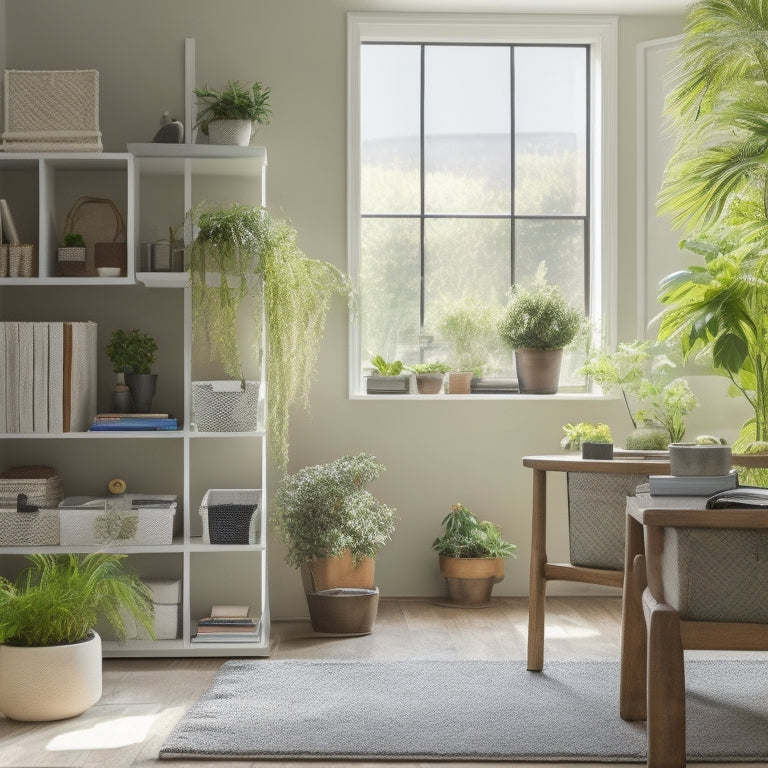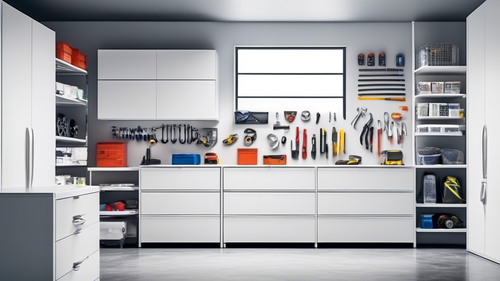
Get Organized: Your Complete Home Organization Guide
Share
You're ready to transform your living or work space into a highly functional and clutter-free zone. Start by gathering essential tools like labels, bins, and shelves, and commit to maintaining your space. Purge and donate items no longer needed, then sort and categorize items into logical groups. Assign a home for each item and establish routines to prevent clutter from returning. Set aside time each week to maintain your space, and schedule monthly deep cleaning sessions. With these habits in place, you'll be well on your way to a organized home. Now, it's time to tackle the specifics of organizing and categorizing your spaces.
Key Takeaways
• Gather necessary tools like labels, bins, and cleaning products to establish a solid foundation for your organizational project.
• Declutter and categorize spaces by purging unwanted items, sorting items into groups, and assigning a home for each category.
• Implement storage solutions and maintain organization by assigning a home for each item, storing frequently used items accessibly, and designating specific places for items.
• Establish routines to maintain your organized home, including daily quick pick-ups, weekly storage maintenance, and monthly deep cleaning.
• Regularly assess and adjust your storage needs through quarterly space optimization and seasonal organization updates to ensure your home remains organized and clutter-free.
Prepare for Organization Success
To set yourself up for organization success, start by gathering the necessary tools and supplies, including labels, bins, shelves, and cleaning products, to create a solid foundation for your organizational project. This will help you declutter efficiently and implement storage solutions that work for you.
With your tools in hand, you'll be able to tackle cluttered areas with confidence. Begin by clearing out trash and donating items that are no longer needed. Then, sort items into categories and assign a home for each group. This process will help you identify what you need to store and how to store it effectively.
Organize and Categorize Spaces
Now that you've purged and sorted your belongings, it's time to categorize spaces by evaluating which items belong in each room and dividing them into logical groups. This step is pivotal for space optimization and will help you make the most of your available space.
To get started, go through each room and identify the categories of items that belong there. For example, in your home office, you may have categories for office supplies, paperwork, and electronics.
Here are three decluttering tips to keep in mind:
-
Group similar items together: This will make it easier to find what you need and prevent clutter from building up in the future.
-
Assign a home for each item: Designate a specific place for each item, making it easier to maintain your space.
-
Keep frequently used items accessible: Store items you use regularly in easy-to-reach locations to save time and effort.
Maintain Your Organized Home
You'll need to establish habits and routines to maintain your newly organized home, ensuring that clutter doesn't creep back in and undo all your hard work. Set aside time each week to maintain your space, whether it's 15 minutes a day or an hour on the weekend. Create a schedule that works for you and stick to it.
| Task | Frequency | Tips |
|---|---|---|
| Quick pick-up | Daily | Focus on high-traffic areas |
| Storage maintenance | Weekly | Check expiration dates, clean containers |
| Deep cleaning | Monthly | Focus on one area or room at a time |
| Space optimization | Quarterly | Assess and adjust storage needs |
| Seasonal organization | Seasonally | Update storage for seasonal items |
Frequently Asked Questions
How Do I Stay Motivated During the Organization Process?
"Start by setting sparkling success goals and scheduling sweet rewards to stay motivated. Find fascinating inspiration online, and fetch friendly support from family or friends to fuel your organizational fire and keep it burning bright."
Can I Reuse Old Storage Containers or Should I Buy New Ones?
You can reuse old storage containers, but consider DIY organization solutions like upcycling cardboard boxes or repurposing household items to create functional storage alternatives that save you money and reduce waste.
What if I'm Unsure What to Do With Sentimental Items?
When dealing with sentimental items, you're not just decluttering objects, you're managing emotions. Take time to acknowledge the memories, then consider keeping a few select items, and find ways to preserve the memories without keeping everything.
How Often Should I Review and Update My Organized Spaces?
"Did you know that 80% of clutter is due to disorganization, not lack of space? You'll maintain progress by establishing routines to review and update your organized spaces every 3-6 months, ensuring your hard work doesn't unravel over time."
Are There Any Specific Organization Methods for People With Disabilities?
You can adapt organization methods to fit your needs by using accessible solutions, like adjustable shelving and adaptive strategies, such as color-coding labels or using assistive technology to make organization more manageable.
Related Posts
-

Concealing Garage Storage: Tips for a Tidy Space
Are you ready to transform your chaotic garage into an organized haven? With a little planning and effort, you can...
-

Best Stackable Containers for Flour Storage
When it comes to storing flour, you need stackable containers that prioritize freshness and organization. Look for ai...
-

Granite Top Island Design and DIY Installation
You're planning to create a stunning granite top island that enhances your kitchen's functionality and style. To get ...


